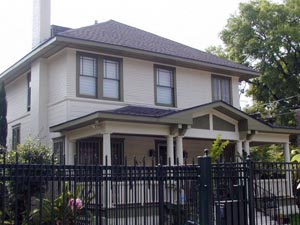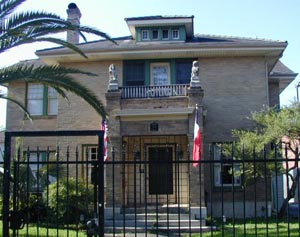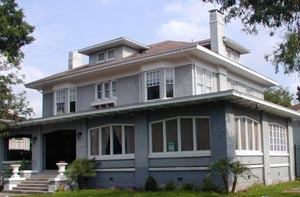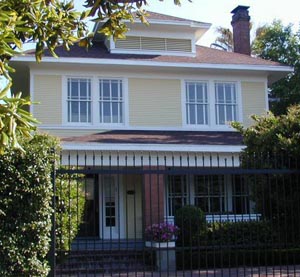




Avondale East & West
History and Culture
Avondale East was designated as an historic district in November 1999. The designation was based on its value as a visible reminder of Houston’s development, from 1907–1928. Avondale West was designated as an historic district in September 2007 based on its development period from 1912–1928. The neighborhood’s significance is associated with the developers, architects, builders, many notable residents; and its architecture. Architects and builders who built homes in Avondale included Fred Marett, E. L. Crain, and the Russell Brown Company of Dallas and Houston. Charles Oliver designed homes for the Russell Brown Company before becoming the staff architect for the River Oaks Corporation.
Avondale East contains the neighborhood’s unique red sidewalks and curbs. The concrete was tinted red to complement green lawns and trees. The red sidewalks were also supposed to reduce glare. They were only placed in the 100 through 300 blocks of Avondale and Stratford Streets, between Baldwin and Taft. Some of the red sidewalks remain in that area.
The Russell Brown Company built custom homes for Houston’s upper and middle class. The company was founded by Russell Brown in 1908. It designed and built more than a dozen homes in Avondale between 1908 and 1925. These included seven houses on prestigious Avondale Avenue, at 104, 216, 218, 410, 501, 503, and 610 Avondale. The company went on to build many homes in River Oaks and other affluent Houston neighborhoods, including Courtlandt Place, Broadacres, Montrose, River Oaks, and Westmoreland.
Houston homebuilder Edward Lillo Crain also built houses in Avondale. Today, Crain is best known for his “Crain Ready Cut House” kits. The kits contained plans, instructions, and all of the materials necessary to construct a house, in the correct quantity and already cut to size. Most Crain Ready Cut House kits were for small houses. Crain also built high-end custom homes, including several in Avondale.
Notable Homes and Residents
Avondale East
The August C. Bering House (now demolished) was located at 101 Avondale. August C. Bering, Sr., ran Houston’s very first lumber company, which his father and uncle had founded around 1850. His son August C. Bering, Jr., founded Bering Lumber Company in 1940. In 1952, August Bering III moved the company to the corner of Westheimer and Potomac, where one of its stores is still located today. The Bering home was built in the Neoclassical style. It was torn down to make way for apartments. The Corinthian columns from the house were used on the apartment building.
The house at 104 Avondale was built in 1917 for William and Helen Turnbow. William Turnbow was the president of Gulf Coast Oil. This Prairie-style brick house was built by the Russell Brown Company. Angie Frank Smith later lived at 104 Avondale. Smith was the bishop of the Methodist Episcopal Church, South, from 1934 until he retired in 1960. The Turnbow-Smith House was designated as a City of Houston Protected Landmark in 2008. J. T. Figg and his brother Howard came to Houston from Indiana. The J. T. Figg Realty Company handled mostly agricultural land sales. J. T. Figg’s Craftsman-style home at 106 Avondale (now demolished) was built in 1911.
C. M. Malone’s house at 109 Avondale (now demolished) was one of the first homes built in Avondale. Malone was an influential Houston businessman. He was involved in railroads and banking. He also was the secretary of the Banker’s Trust Company, founded in 1909 by Jesse Jones to bring foreign investments into Houston.
The John and Florida Bishop House, 110 Avondale, was one of the first houses built in the neighborhood. It is a grand home built in the Colonial Revival style.
The house at 206 Avondale was built by the Russell Brown Company for attorney William Hill.
William L. Connelly House, 218 Avondale, was built by the Russell Brown Company. Connelly was the regional supervisor for the Sinclair Oil Company and company president Harry Sinclair’s right-hand man. This house became a City of Houston Protected Landmark in 2006. It is outside the boundaries of Avondale East Historic District.
Neal Pickett was the mayor of Houston during World War II. He lived at 217 Avondale, which is also outside the boundaries of Avondale East.
The Edmundson House–Parsonage of the Houston District, Methodist Episcopal Church South at 108 Stratford was designated as a Protected City Landmark in 2006. The house is in the American Four Square style with Prairie details and was built in 1912.
Avondale West
Abe and Esther Levy, who owned the Levy Dry Goods stores, resided at 309 Avondale. That house, built in 1912, is a modified American Four Square with Prairie details.
James House lived at 404 Avondale. He was the son of prominent Houston banker T. W. House. James’ brother, Edward Mandell House, was a confidant of President Woodrow Wilson. This home is one of many in the neighborhood featuring elements of the Prairie style of architecture.
Fred Hutchinson was one of the many independent oil producers in the region. He lived at 410 Avondale.
Lawrence P. Scarborough, an investment banker, lived at 412 Avondale. That house is now a City Protected Landmark. Scarborough later sold the house to J. K. Warren, president of the Warren-Cleveland Lumber Company.
Samuel Bashara invented a patented process that helped oil field workers clean bore holes during oil drilling. He lived in the Colonial Revival house at 414 Avondale.
Ross Sterling founded Humble Oil Company and served as the Governor of Texas from 1931–1932. He lived at 600 Avondale.
Judge William Love, the first mayor of Houston Heights, lived at 603 Avondale with his family. A later resident of that Prairie-style home was J. Robert Neal was the vice president of the Cheek Neal Coffee Company, which later became Maxwell House Coffee.
Albert Bath managed the cotton exporting firm of Felix P. Bath & Company. His daughter, Harriet, founded and was a lifelong supporter of the Houston Ballet. The Bath home at 609 Avondale was built by Edward Crain. Harriet Bath lived in the house until her death in 2006.
George Meyer and Joe Meyer Jr., sons of Avondale developer Joseph F. Meyer Sr., lived in the neighborhood. George Meyer went on to develop the Meyerland subdivision in southwest Houston in the 1950s.